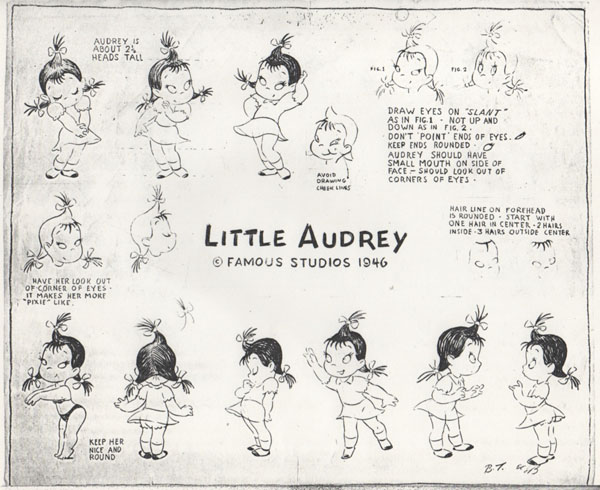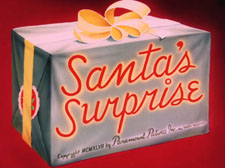
A super short post this as we’re working on getting Thunderbean stuff taken care of. We’re trying to get as many things out the door as possible in the next few days, and it’s finals week at the school, so this one is brief!

Since we’re working on Noveltoons here, I’ve had that certain ‘sound’ of the Paramount Cartoon orchestration humming in my head a lot, so when I was thinking about what to show this year I thought about Santa’s Surprise (1947). This (was) an especially hard cartoon to find a decent print on, and I think the only 35mm that has surfaced on it belongs to Paul Mular (who was kind enough to lend his 35mm for film scanning when we were working on ‘Yuletide Flickers’ a few years back.

It’s nice to see the Famous Studios animators try to make a film that includes children from around the world; the simple story is one of the more enjoyable aspects of the film and serves as a good centerpiece for the series of gags that comprise the majority of the film. Unfortunately (and predictably) the usual stereotypes are present. I’m sure the Famous Studios staff approached these ideas as a reflection of the culture and time they were in without considering them much further; viewing today, I find the overall characterizations to be silly, playing into the simplest ideas of cultures around the world without much if any actual research. I have to wonder how this particular cartoon imported into other countries, especially those they attempt to represent!
 Myron Waldman serves as the (real) animation director of the short, as Famous carries on the Fleischer tradition of credits. Waldman was especially proud of this particular cartoon (one of the few films he mentioned the handful of times I talked with him) and had hoped to find a better copy than the VHS tape he had on the film that contained a reddish NTA print. As it was almost always with Waldman, he was short on actual details about each particular thing he had worked on. I wish I has pressed him a little more to elaborate on what he liked about the film. You can clearly see that he’s going for charm above all else, and it is a really cute short.
Myron Waldman serves as the (real) animation director of the short, as Famous carries on the Fleischer tradition of credits. Waldman was especially proud of this particular cartoon (one of the few films he mentioned the handful of times I talked with him) and had hoped to find a better copy than the VHS tape he had on the film that contained a reddish NTA print. As it was almost always with Waldman, he was short on actual details about each particular thing he had worked on. I wish I has pressed him a little more to elaborate on what he liked about the film. You can clearly see that he’s going for charm above all else, and it is a really cute short.
Happy Holiday’s to everyone!


 Steve Stanchfield is an animator, educator and film archivist. He runs Thunderbean Animation, an animation studio in Ann Arbor, Michigan and has compiled over a dozen archival animation DVD collections devoted to such subjects at Private Snafu, The Little King and the infamous Cubby Bear. Steve is also a professor at the College for Creative Studies in Detroit.
Steve Stanchfield is an animator, educator and film archivist. He runs Thunderbean Animation, an animation studio in Ann Arbor, Michigan and has compiled over a dozen archival animation DVD collections devoted to such subjects at Private Snafu, The Little King and the infamous Cubby Bear. Steve is also a professor at the College for Creative Studies in Detroit.






















I know it doesn’t alleviate the usual problem with these kinds of films of this particular era, but cartoons involving children are always a little more “cuddly” if actual children do the voices of children, no matter what the race. The involvement of the child actors sometimes adds that dimension that is lost when caricatures or stereotypes abound too frequently.
I genuinely liked the MGM Bosko when he was voiced by a child. I wished that were so for the entire MGM run. If you’ve ever seen “BOSKO’S PARLOR PRANKS” (or is the cartoon only titled “PARLOR PRANKS”?), you’ll see what I mean as Bosko sounds like an actual child. However, seeing Famous Studios cartoons of this vintage is always exciting merely because the animation is so incredibly special. I’d always felt that, if any of the other animation studios worked to create feature films, we might have seen so much more diversity. The Fleischers tried with limited success, and I guess that MGM never considered such a project; imagine, for example, if “THE WIZARD OF OZ” was animation instead of live action, perhaps with the same acting cast providing the voices.
I don’t know what the solution would be to retain animation in theaters like in the golden age, when you got an animated short with your movie-going experience and pop corn, but I am grateful to all of you connected with Cartoon Research for all you continue to do to make sure that fans get the genuine article, without interference from those who don’t understand why we want to keep all these classic films alive. Aside from an unreal view of the world, animation of this age has so much to recommend it, and this includes amazing scoring and amazing voice acting, even in the situations that might seem uncomfortable to some.
Animation was flourishing during this time, and many shorts were quite good, even if they weren’t winning Oscars for their visual brilliance. The art form should always be celebrated, realizing that the film you are watching in modern times often reflects how Hollywood looked at the world and our own country at the time of the film’s creation. There is still much to influence students of the art today to perhaps take a negative and turn it into the positive film that you’d think the animation staff actually meant to create.
Happy Holidays and the best of New Years. 2019 hopefully will bring out more restored goodies to discuss and reacquaint ourselves with.
If memory serves, this was actually the first cartoon film to feature “Little Audrey” who was created primarily so that Paramount didn’t have to negotiate licensing for the “Little Lulu” comic strip character. that they had featured since 1943, There is a 16mm low fade reduction print available on Ebay currently, of this title, which may well have been sourced from the 35mm print Steve described. The animation and color on this film was first rate, but I never really liked the cloying nature of it, like many Paramount efforts, Their heart was in the right place, but as Steve noted, the stereotyping was just far too cookie cutter to really portray the messaging with much sincerity.
Steve recently posted a pic of a transfer of Little Lulu in a candy shop. Does anyone know which short that is and which Thunderbean it’ll be included on? Thanks!
Famous was still not locked into formula in the mid-to-late 40s, and was still doing cartoons like this one, or others like “The Wee Men” or “The Enchanted Square” which weren’t the type of slapstick cartoons that Warners and MGM has perfected, while Waldman’s stores even during the Fleischer years always drifted the closest to Disney territory. Seen in 70-year hindsight, the characterizations here are a little cringe-worthy, but they’re not malicious as some of the racial visualizations of the 1930s and early 40s could be, either at Famous or at other studios.
Did Myron Waldman create “Little Audrey”?
Bill Tytla based the design on his daughter—to the best of my knowledge.
Jerry Beck did a long article on the “Secret History of Little Audrey. It is here:
https://cartoonresearch.com/index.php/the-secret-history-of-little-audrey/
It can be ascertained from Jerry’s article that Little Audrey had THREE immediate creators. In terms of design and persona, those can be broken down into three categories:
1) Bill Tytla made the first ever design of Audrey dating back to 1946, a year before her debut. He would go on to supervise four of her animated stories, most notably with his strong posing in 1948’s “The Lost Dream”.
2) Steve Muffati played a major role in refining Audrey’s animated and comic book persona. He received co-writers’ credit for “Lost Dream”, before becoming animator/director for her series up to 1953. His comic book works for the character led to her character redesign for both comics and animation by 1952, specifically when Famous Studios’ comic book deal transferred from St. John’s to Harvey.
3) Larz Bourne wrote the inaugural Audrey short, “Santa’s Surprise”, as well as writing several other shorts.
The main fascination is that Audrey was not just a one-note knockoff, which given Famous’ creative environment, she very well could’ve been. The artists did a lot of research in reviving a name from common folklore, and creating a character who could be easily distinguishable from Little Lulu, even though the main purpose was to replace Lulu. Audrey would definitely take on a life of her own, particularly in the comic books long after her animated series ended.
That’s a gorgeous print, especially compared to the 99-cent store DVD versions I’ve seen. Thank you.
I forget the name of the voice actor who is doing the Chinese boy, the Russian boy and the Dutch boy, but I hear him in every Paramount color cartoon from Popeye to Superman, and his high, nasal voice grates on me like you don’t know – I don’t know why but I just can’t stand his voice!
I wonder if the Dutch boy helped with the paint!
That’s Jack Mercer with the “high nasal voice” doing the Chinese, Russian and Dutch boys, especially the singing. Cecil Roy, who used to be the voice of Little Lulu, does the black boy and the singing for the little girl who is doing the sewing. I wonder if she resented Mae Questel becoming the lead voice of Little Audrey?
I have a sneaking suspicion that the opening of this cartoon has been barbered somewhat over the years, and that some effort at restoration had been made.
I suspect that, in an “original”opening (if such still exists) that one of the stars either leaves the Paramount corona or emerges from the peak of the mountain (as in the “Popeye” and “Little Lulu” series). Instead of zooming into center screen, however, it floats up to the top to become the star atop the Christmas tree.
Yes it is a special opening. and yes it still exists. The PD technicolor print has that part left in(there are 2 PD prints in circulation a NTA print and a Technicolor print with orginal titles that was likely sourced from the rental prints that NTA used for circulation). The star on the Paramount Corona turns yellow and zooms slowly towards the camera as the logo fades then becomes the star on top of the tree.
At the 5:01 mark, you can tell there is a splice. All that’s missing is two quick little snippets of one child pocking her head out of a mug, and then a boy poking his head out of Santa’s left boot.